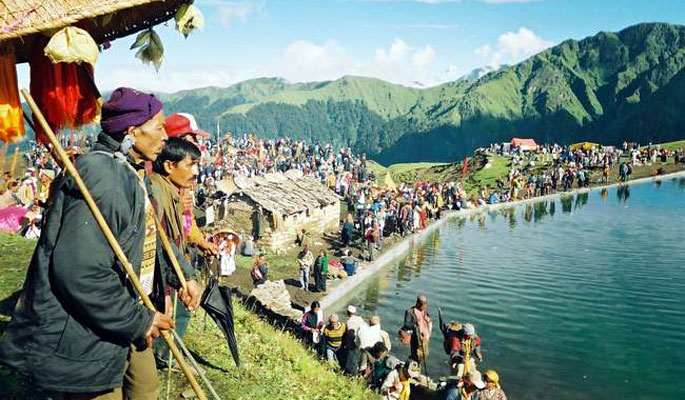
All social units develop a culture. Thus it is the inhabitants of a specific region that collectively contribute to form that extraordinary cornucopia of life we call culture.
In case of Uttarakhand, the Land of Gods, natural diversity and the element of the Himalaya’s unparalleled beauty and sanctity add a new dimension to the word ‘culture’. The people of the state are as diverse as the landscape. Uttarakhand is blessed with a whole multiplicity of culture greatly influenced and inspired by its geo-social factors. The ancient cultural traditions of Uttarakhand are deep rooted primarily in religion. Music, dance and arts are a manifest for the firm religious bonds of the people with the awe-inspiring Himalayas.
“In those lovely valleys there is still the romance and poetry of life: each tree has its god, each bush its spirit” – So wrote the 19th century British anthropologist and surveyor Charles A. Sherring, describing a fair part of Uttarakhand, in his great research ‘Western Tibet and British Borderland’.
All the local traditions of the state are determinedly attached to nature and its bounty. No legends or myths are complete without nature, seasons or the Himalayas being integral part of them. The people spare no opportunity to celebrate this bountiful natural, social and religious diversity.
Collective celebrations become the order of the day – the many fairs and festivals bear testimony to this. These fairs have now become remarkable stages for all sort of uncluttered social, cultural and economic exchange. Visitors from far and wide are drawn to these events in multitudes.
The state offers journey-options to both – the religious and the spiritual.
There are a number of religious events attached to River Ganga - the holiest of all the rivers.
Daily aartis performed every evening at the banks of the Mother-River in Haridwar and  Rishikesh present a memorable sight to behold when the star studded sky seems to be reflecting the serene waters of the river upon the surface of which float countless diyas offered to the goddess. The Kumbh Mela that is held every twelve years witnesses some of the largest gatherings of devotees to be seen anywhere in the whole world.
Rishikesh present a memorable sight to behold when the star studded sky seems to be reflecting the serene waters of the river upon the surface of which float countless diyas offered to the goddess. The Kumbh Mela that is held every twelve years witnesses some of the largest gatherings of devotees to be seen anywhere in the whole world.
Overwhelming natural panoramas accompany the pilgrims taking part in the Nanda Devi Raj Jaat and Kailash Mansarovar Yatras. The shrines of Hemkund Sahib and Nanakmatta Sahib are visited by thousands of Sikh devotees while a symbol of national integration - the Dargaah at Piran Kaliyar Sharif, holds a significant religious rank for Muslims and people from other faiths alike.
Several indigenous tribes and communities flourish in this state today maintaining their distinct cultural heritage and traditions. The several fairs and festivals celebrated by the tribes such as Bhotias (Shaukas), Tharus, Buxas and Jaunsaris are opprtunies for the locals and the visitors to witness these events as opportunities to keep the traditional modes of life and art alive apart from providing them the recognition they so strongly deserve.
People from all communities participate in these Melas and one can see the camaraderie among the masses, reflected in the collective pleasure experienced by one and all.
- Kumbh Mela at Haridwar: Kumbh Mela is probably the largest religious gathering anywhere around the world. Though all the Kumbh Melas are attended by millions of pilgrims, the name of Haridwar comes at the top of all Indian pilgrimages. Therefore the Kumbh Mela of Haridwar enjoys exceptional media coverage and Tourist traffic. The place is termed as the gateway to heaven in Hindu mythological scriptures.
- Kanvad Yatra: An annual pilgrimage is taken up by the followers of Lord Shiva in North India during the rainy months of Shravan
- Magh Mela: The Magh Mela is held annually, other than the years of Kumbh and Ardh Kumbh and is rightfully called the annual mini Kumbh Mela.
- Bissu Mela: The Jaunsari tribals of Uttarakhand celebrate a week long Bissu Fair marking the happiness and prosperity.
- Nanda Devi Raj Jaat: The Nanda Raj Jat offers an unparalleled and complete experience to the travelers with interest in local cultural. The 280 kilometres and 19 days trek starts from Nauti Village and reaches Homkund via the amazingly picturesque Bedini Bugyal, Roopkund and the very difficult Jyura Gali pass, on Nandashtmi.
- Kangdali Festival: Kangdali Festival is a celebrated by the Rung (Shauka) tribals of the Chaundas valley in Dharchula of the Pithoragarh District.
- Nandadevi Mela: Nanda Devi is the chief patronizing Goddess of Uttarakhand and several shrines are devoted to her all across the central Himalayas.
- Poornagiri Mela: On the Annapurna range, the temple of Shri Purnagiri organises the Purnagiri Mela in Uttarakhand on Navratri.
There are many more festivals celebrated in the Uttarakhand through out the year. Come to visit land of the God and enjoy the beauty and views of the place.
This slideshow requires JavaScript.
